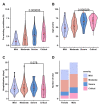Risk of Death in Comorbidity Subgroups of Hospitalized COVID-19 Patients Inferred by Routine Laboratory Markers of Systemic Inflammation on Admission: A Retrospective Study
- PMID: 35746672
- PMCID: PMC9228480
- DOI: 10.3390/v14061201
Risk of Death in Comorbidity Subgroups of Hospitalized COVID-19 Patients Inferred by Routine Laboratory Markers of Systemic Inflammation on Admission: A Retrospective Study
Abstract
Our study objective was to construct models using 20 routine laboratory parameters on admission to predict disease severity and mortality risk in a group of 254 hospitalized COVID-19 patients. Considering the influence of confounding factors in this single-center study, we also retrospectively assessed the correlations between the risk of death and the routine laboratory parameters within individual comorbidity subgroups. In multivariate regression models and by ROC curve analysis, a model of three routine laboratory parameters (AUC 0.85; 95% CI: 0.79-0.91) and a model of six laboratory factors (AUC 0.86; 95% CI: 0.81-0.91) were able to predict severity and mortality of COVID-19, respectively, compared with any other individual parameter. Hierarchical cluster analysis showed that inflammatory laboratory markers grouped together in three distinct clusters including positive correlations: WBC with NEU, NEU with neutrophil-to-lymphocyte ratio (NLR), NEU with systemic immune-inflammation index (SII), NLR with SII and platelet-to-lymphocyte ratio (PLR) with SII. When analyzing the routine laboratory parameters in the subgroups of comorbidities, the risk of death was associated with a common set of laboratory markers of systemic inflammation. Our results have shown that a panel of several routine laboratory parameters recorded on admission could be helpful for early evaluation of the risk of disease severity and mortality in COVID-19 patients. Inflammatory markers for mortality risk were similar in the subgroups of comorbidities, suggesting the limited effect of confounding factors in predicting COVID-19 mortality at admission.
Keywords: COVID-19; comorbidity; inflammatory markers; model; severity predictors.
Conflict of interest statement
The authors declare no conflict of interest.
Figures







References
MeSH terms
Substances
LinkOut - more resources
Full Text Sources
Medical
Research Materials
Miscellaneous

